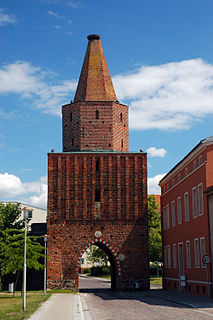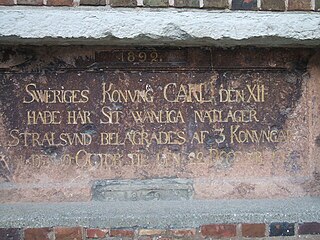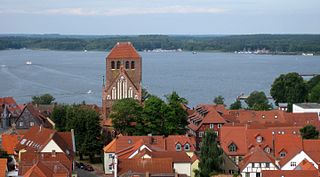 W
WThe Battle of Gadebusch or Wakenstädt was Sweden's final great victory in the Great Northern War. It was fought by the Swedes to prevent the loss of the city of Stralsund to Danish and Saxon forces.
 W
WThe successful Landing on Groß Stresow by Prussian, Danish and Saxon troops took place on 15 November 1715 on the island of Rügen, Germany during the Great Northern War. The landing was followed with cavalry assaults from the Swedish defences on the island, commanded by Charles XII king of Sweden who despite the huge numerical disadvantage of - one up against five - chose to attack the fortified camp. The Swedes managed to get past the "Cheval de frise" and break through, but was then rapidly repulsed and routed after taking heavy casualties.
 W
WThe invasion of Rügen of 22 to 24 September 1678 was a military operation in the Swedish-Brandenburg War, or Scanian War, that ended with the annexation of the Swedish-ruled island of Rügen by the Allies: Brandenburg-Prussia and Denmark.
 W
WThe Battle of Neuensund was a smaller battle at Neuensund of the Seven Years' War between Swedish and Prussian forces fought on September 18, 1761. The Swedish force under the command of Jacob Magnus Sprengtporten managed to rout the Prussian forces commanded by Wilhelm Sebastian von Belling.
 W
WThe Capitulation of Pasewalk on 29 October 1806 resulted in the surrender of Oberst (Colonel) von Hagen's 4,200 Prussian soldiers to an inferior force of two French light cavalry brigades led by Generals of Brigade Édouard Jean Baptiste Milhaud and Antoine Lasalle. The Prussians were completely demoralized after a two-week-long retreat following their decisive defeat at the Battle of Jena-Auerstedt. Pasewalk is 110 kilometers north of Berlin and about 40 kilometers west of Szczecin (Stettin), Poland.
 W
WThe Siege of Stralsund was a siege laid on Stralsund by Albrecht von Wallenstein's Imperial Army during the Thirty Years' War, from May to 4 August 1628. Stralsund was aided by Denmark and Sweden, with considerable Scottish participation. The lifting of the siege ended Wallenstein's series of victories, and contributed to his downfall. The Swedish garrison in Stralsund was the first on German soil in history. The battle marked the de facto entrance of Sweden into the war.
 W
WThe Siege of Stralsund was an armed engagement between the Electorate of Brandenburg and the Swedish Empire from 20 September to 15 October 1678, during the Scanian War. After two days of bombardment on 10 and 11 October, the severely devastated Swedish fortress of Stralsund surrendered to the Brandenburgers. The remainder of Swedish Pomerania was taken by the end of the year, yet most of the province including Stralsund was returned to Sweden by the terms of the Treaty of Saint-Germain-en-Laye and the Peace of Lund, both concluded in 1679.
 W
WThe Siege of Stralsund was a battle during the Great Northern War. The Swedish Empire defended her Swedish Pomeranian port of Stralsund against a coalition of Denmark-Norway, the Electorate of Saxony and the Tsardom of Russia, which was joined by the Kingdom of Prussia during the siege.
 W
WThe Siege of Stralsund lasted from 24 July to 24 August 1807 and saw troops from the First French Empire twice attempt to capture the port city from Lieutenant General Hans Henric von Essen's 15,000-man Swedish garrison. Early in the year, Marshal Édouard Adolphe Casimir Joseph Mortier blockaded the city for two months before he was called elsewhere. In his absence, the Swedes drove back the inferior blockading force. After Mortier returned and pushed Essen's troops back in turn, the two sides quickly concluded an armistice. The truce was later repudiated by King Gustav IV Adolf of Sweden, whereupon Marshal Guillaume Marie Anne Brune led 40,000 French, German, Spanish, Italian, and Dutch soldiers against the fortress. Fearfully outnumbered, the Swedes abandoned the Baltic Sea port of Stralsund to the Franco-Allies in this action during the War of the Fourth Coalition, part of the Napoleonic Wars. As a consequence, Sweden also lost the nearby island of Rügen.
 W
WThe battlefield of the Tollense valley is a Bronze Age archaeological site in the northern German state of Mecklenburg-Vorpommern at the northern edge of the Mecklenburg Lake District. The site, discovered in 1996 and systematically excavated since 2007, extends along the valley of the small Tollense river, to the east of Weltzin village, on the municipal territories of Burow and Werder.
 W
WThe Battle of Waren-Nossentin on 1 November 1806 saw soldiers of the Kingdom of Prussia led by August Wilhelm von Pletz and Ludwig Yorck von Wartenburg fight a rear guard action against troops of the First French Empire commanded by Marshal Jean-Baptiste Bernadotte. Though forced to give ground, the Prussians successfully kept the French from inflicting serious loss or cutting off any units in this War of the Fourth Coalition action. Waren lies on the northern end of Lake Müritz, about 70 kilometres (43 mi) southeast of Rostock. Nossentin is a small village on the Fleesen See about 15 kilometres (9 mi) due west of Waren.